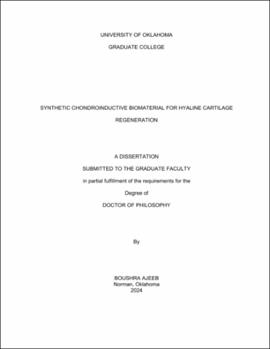| dc.description.abstract | Avascularity, low cell count, and low proliferative potential constitute the triad that defines the limited self-regenerative potential of articular cartilage. Consequently, the repair of articular cartilage defects presents a highly challenging task for researchers and orthopedic surgeons. Despite the progress in currently available treatments, including surgical and regenerative cell therapy techniques, the regeneration of a tissue that completely mimics the biochemical and mechanical properties of articular cartilage has not yet been successful.
Among a multitude of approaches being investigated to induce hyaline cartilage regeneration, the design of an acellular chondroinductive biomaterial would provide a safe, cost-effective, and translational approach toward successful true hyaline cartilage regeneration.
In this dissertation, the objective was to design a chondroinductive hydrogel to induce the chondrogenic differentiation of human bone marrow-derived mesenchymal stem cells (hBMSCs). The base of the biomaterial was a pentenoate-functionalized hyaluronic acid (PHA) hydrogel along with a conjugated chondroinductive factor.
The search for a chondroinductive factor started with the evaluation of two peptides and two small compounds from the literature with human and equine BMSCs; however, no evidence of chondroinduction was observed with any of the peptides or compounds. The search continued with the evaluation of the chondroinductive potential of 11 newly discovered peptides with no success. Hence, and as a contingency plan, I resorted to the use of a peptide (Peptide D), based on preliminary results (from others on our team) with hBMSC spheroid cultures, which suggested that Peptide D could enhance the chondrogenic differentiation of hBMSCs in the presence of transforming growth factor (TGF)-β3. Therefore, the final objective of this dissertation was to synthesize a PHA hydrogel with conjugated Peptide D and conjugated TGF-β3. Varying concentrations of Peptide D and TGF-β3 were evaluated, and I identified a combination that resulted in the upregulation in the gene expression of collagen II and SOX-9 compared to hydrogels with conjugated TGF-β. This outcome signifies the successful synthesis of a promising chondroinductive biomaterial.
The results obtained in this dissertation were the basis to select promising hydrogel groups to evaluate in a currently ongoing in vivo cartilage regeneration study in rabbits. Future work beyond this thesis will focus on advancing the hydrogel-peptide-TGF-β3 system based on the outcome of the current in vivo study, and to refine the sequence of Peptide D in efforts to enhance its chondroinductive potential. | en_US |
